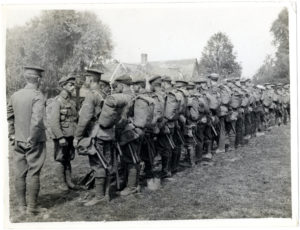Thursday May 2nd, 1918
Reveille 6:30. Found my valise covered with mud. Drill suits issued out and shorts and warned for Quarter Guard for Saturday morning. Feel quite loose in shorts.
Steel Helmets
Today the Battalion’s diary announces the issue of summer uniforms and a limited number of tepees. Unfortunately men not issued with a tepee must wear their steel helmets ‘with cover and flaps’ between 10am and 4pm to ward off the sun. Wearing a metal hat in baking hot weather sounds pretty awful.
Steel helmets were an invention of WWI. Every army went to war in 1914 with caps and helmets that offered no protection to their wearers. The French were the first to provide steel helmets to their troops – initially one that was designed to be worn under the soldier’s cloth kepi. The British and Germans soon followed suit.

© IWM (UNI 6105).
By autumn 1915, the Brodie helmet was being deployed to British and Commonwealth troops. It was a simple design using a single sheet of pressed metal. Within months its design was improved, with the introduction of thicker plate, a blunted rim, and with paint, sand and cork added for camouflage.¹ The helmet shown here is a MK1 from the collection of the IWM. It has many of these enhancements – a drab khaki textured paint finish, a steel edge on the helmet’s rim and a leather chinstrap.*
Captain Stewart wrote, ‘When the so-called tin helmets were first issued none of us liked them. After a time I liked mine so much that, when in the tenches, I never took it off for days on end and always slept in it. …. They saved many lives.’²
All variations used a suspension system inside the helmet, usually made of leather and fabric. This made the helmets more comfortable and provided a buffer between steel and skull. Presumably this also helped in their adaptation to sun-wear.
The Valise

Frank finds his ‘valise’ (also known as the ‘large pack’) today and it is covered in mud. If the march from the front line to Saida had been under ‘Full Marching Order’, Frank would have been wearing his valise as part of his 1908 pattern webbing equipment. However, for once, the men’s packs were transported for them. Unfortunately, Frank’s didn’t arrive completely unscathed.
When in “Full Marching Order” the large pack or valise was worn on the back and the haversack was worn hanging by the left hip. The photograph shows men of the 2nd Leicesters on parade, in Full Marching Order, just before setting off for the trenches at Estaires in France in August 1915.^
When in “Battle Order”, a mode intended for combat, the valise was removed and the haversack attached in its place, connected to the ammunition pouches by separate straps.³
13th (Service) Battalion War Diary – 2nd May 1918 – Saida
The Battalion rested, bathed and washed. The main works for the Battalion for the present will be the canalization of all the ravines and tributaries from the junction of Clichy and Gun Ravines eastward towards Commandant and Palliasse, and the same with the ravines at the northern end of the Bujuklu Ravine.
Routine commencing tomorrow will be as follows:- Reveille 06:00 hrs, Breakfast 07:00 hrs, Work 08:30 to 10:30 hrs, Dinner 12:30 hrs, Tea 16:00 hrs Work 17:30 hrs -19:30 hrs.
The Battalion is now being fitted with Khaki drill jackets and shorts and a proportion of topees has arrived. Those men without topees wear the steel helmet with cover and flap between the hours of 10:00 and 16:00 hrs. Sunproof dining shelters are being constructed in all camps. They consist of framework with thick reed matting roofs. The men sleep in mosquito proof bivouacs by night and live in dugouts and tents by day. For the present, jackets and trousers SD will be worn by all night working parties.
References & Further Reading
¹ ‘Steel Helmets‘, International Enclyclopedia 1914-18
² ‘A Very Unimportant Officer’ by Captain Alexander Stewart & Cameron Stewart (2008), Kindle Locn 879
³ 1908 Pattern Webbing on Wikipedia
* UNI 6105, copyright Imperial War Museums.
^ Photograph of 2nd Leicesters, Wikimedia Commons (image may be subject to copyright)
Interior Markings on British Uniforms on Gunboards for Collectors


